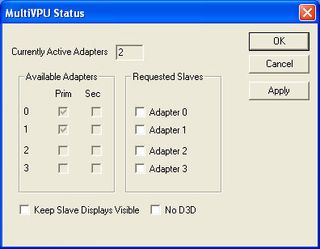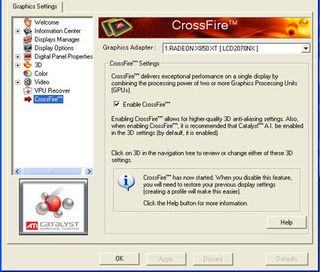ATI Puts NVIDIA's SLI in the CrossFire
Practical Test
The Crossfire-enabled drivers on ATI's demo PC were still at the prototype stage. The selection of options and the scope of functions may change in the final version. Currently, users can only switch dual mode on or off. In contrast to SLI, a reboot should not be necessary. Whether multi-display operation is possible with activated CrossFire is not yet certain. This would be a further advantage over NVIDIA's SLI.


A special ATI tool shows the system's multi-VPU status. Below it is the Crossfire menu of the ATI Catalyst driver.
Enthusiasts will be disappointed to learn as things currently stand that they will have no control over the various CrossFire calculation modes. Catalyst A.I. fixes which games run in which rendering modes. If the driver does not recognize the game, the standard mode (SuperTiling) for Direct3D and Scissor for OpenGL applications is selected automatically. Users can only choose SuperAA mode freely.
The CrossFire cards, as they are now, are only distinguishable from the standard Radeon models at second glance. Optically, they can only be identified by the modified display input and output and on the second DVI-TMDS chip from Silicon Image. ATI now wants to place a prominent label on the packaging to show that the card is a CrossFire version (or master card).
Stay on the Cutting Edge
Join the experts who read Tom's Hardware for the inside track on enthusiast PC tech news — and have for over 25 years. We'll send breaking news and in-depth reviews of CPUs, GPUs, AI, maker hardware and more straight to your inbox.
Current page: Practical Test
Prev Page Radeon Xpress 200: Chipsets For AMD And Intel Next Page ConclusionMost Popular

